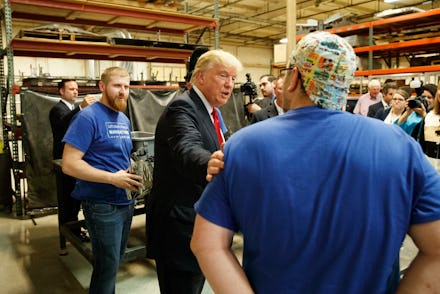3 ways Donald Trump has said he will bring back jobs — that won't work

President-elect Donald Trump won the election in part because of his campaign promises to be a job creator for the American working class. Now his supporters say they expect him to follow through.
Can Trump succeed in revitalizing regions of the United States that have lost millions of manufacturing jobs to offshoring?
Economists say that, in the very short-term, Trump's plans to slash taxes and deregulate industries in energy, financial services and pharmaceuticals could indeed create some jobs — and, it's not just the president-elect: Congressional Republicans are also pushing tax cuts as the right policy to create jobs.
But for the long-term, economists have more of a mixed assessment of Trump's economic plans, given that the large-budget deficits they create could actually cost jobs over the next decade.
Here are three examples of how his promises don't match up with reality.
Government regulations aren't killing coal; natural gas is.
Trump made coal workers a central target of his campaign promises, pledging to eliminate Obama-era environmental regulations, which Trump said were hurting the coal industry.
These promises were key to his securing victory in crucial coal-country states like Pennsylvania and Ohio, the New York Times reported.
Unfortunately for those workers, evidence suggests it's not really regulations that have killed the coal sector. The more likely culprit is the free market — and coal's cheaper, cleaner competitor: natural gas.
Incidentally, as the Times noted, Trump's promise to unravel regulations will likely be a boon to natural gas, since rolling back rules would boost gas exploration and production and make it easier for companies to build pipelines.
That would have the effect of putting more natural gas into the market — making a revival for coal even less likely.
Trump's infrastructure plan does not have job-creation teeth.
Members of Congress are already batting ideas around about how to pay for Trump's proposed $1 trillion dollar infrastructure plan, which the president-elect touted as a way to create thousands of new construction and manufacturing jobs while rebuilding "crumbling" American roads, waterways and pipelines during his campaign.
But economist Paul Krugman and former Vice Presidential Chief of Staff Ronald Klain — who oversaw implementation of President Barack Obama's infrastructure plan — pointed out big problems in the plan.
At the heart of their objections is the heavy use of private financing, in this case through generous tax credits for private companies who take on infrastructure projects.
As Krugman pointed out in the New York Times, this is a wildly inefficient way to dole out government spending, since taxpayers assume 82% of the costs while the private companies ultimately retain ownership.
And Klain has gone so far as to say that Trump's infrastructure plan might not create jobs at all, because it doesn't include any provisions that would ensure the money goes to unfunded projects.
Their thinking goes that if Trump really wanted to fund an infrastructure program, he would propose a bill to increase infrastructure spending specifically.
Trump's insistence on the use of private contractors is simply "corporate welfare," Klain writes. And — as Krugman puts it — it would "enrich a few well-connected people at taxpayers' expense."
Trump's plan to lure back overseas factories will benefit shareholders, not workers.
Trump has suggested he will revitalize manufacturing in the Industrial Midwest, speaking, for example, of the need to "bring back trillions of dollars from American businesses that [are] now parked overseas" during his first major economic policy speech at the Detroit Economic Club in Michigan.
One of the ways he's proposed doing this is through a one-time tax holiday that would let companies move money held offshore back into the United States without paying taxes on it. The idea behind such a provision being that if money comes back, it will be invested in hiring.
The problem?
The U.S. already tried that back in 2004, and a survey of the academic literature by Bloomberg found that some 90% of the money that was repatriated just went to shareholders through dividends and stock buybacks — mechanisms through which companies return cash to investors.
It did not go toward job creation.
Indeed, shoe manufacturers have told Reuters that the idea of them moving production back to advanced economies like the U.S. is a "farce," pointing to the fact that cheap labor is just one of several reasons they elect to produce shoes in Asia — easy access to suppliers is another big one.
And tariffs on foreign-made products — Trump's main weapon against offshoring — are unlikely to be enough to make manufacturing in the U.S. profitable unless consumers pay higher prices.
Finally, Trump's plan does not address the threat of automation: Companies could build products in America rather than Asia, but they still might be more inclined to use robots than U.S. workers.